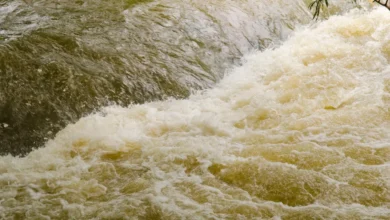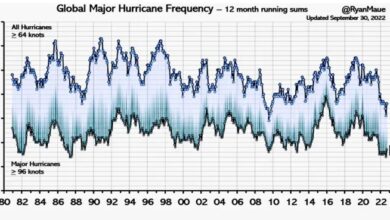Dissipation, continuum mechanics, mixtures and glaciers

by Dan Hughes
A brief continuation of previous discussions about calculation of viscous heat dissipation in the flow of liquids having linear stress/rate-of-strain constitutive description.
The current notes focus on a few papers in the glaciology literature relating to the subject. Papers that applied fundamental continuum mechanics concepts to development of model equation systems for glacier applications is introduced.
These notes are of a nature of short introductions to a few papers and ideas. Very likely of interest to those interested in the subject
Introduction
These notes are a continuation of the discussions initiated in this previous post at CE. The focus is on the mathematical description of viscous heat dissipation of kinetic energy into thermal energy. In the previous notes I identified the textbook by Bird, Stewart, and Lightfoot [1960] as a valid source for such information. The exact same description appears in a multitude of other textbooks. Because the physical phenomenon is of a foundational nature, its description is generally not open to questions and debate about the year of publication.
The material in the textbooks is a summary of the development given by Bird [1957], in which he used the fundamental local-instantaneous equation for balance of kinetic energy to develop a macroscopic formulation of that equation and the generalized mechanical energy balance equation. The latter is a method of including losses due to viscosity into the Bernoulli equation. Bird’s approach seems to be very appropriate because viscous dissipation of kinetic energy involves both kinetic energy and viscosity.
I have looked into development of the formulations for viscous heat dissipation as used in the glaciology literature a little ways back into past time. My review is very limited; the literature is vast and goes back into the 19th century.
Viscous heat dissipation could be considered important because the increased fluid temperature associated with the phenomenon has a potential to cause melting of ice in glaciers beyond what would occur if the process did not exist. Additional melting could potentially affect the amount of meltwater that enters the Oceans, and also could provide lubrication for motion of glaciers by way of liquid films between the bottom of the glacier and the solid materials over which they slide. Both issues have been research subjects.
However, there is uncertainty associated with all applications given the complexity of the application domains. In several aspects, the exact topology of glaciers, both interior too and the bounding surfaces of, cannot be known. Some research uses a sensitivity approach directed toward heat transfer, by changing the initial fluid temperature, for example, or direct variation of the heat transfer coefficient, or assuming that the ice and meltwater are at the melting temperature of the ice at the local pressure. In the latter approach, any additional energy in the fluid, by dissipation for example, goes 100% into melting.
Focused Validation on each potential uncertain aspect is very likely beyond what can be accomplished in the complex physical domain of the applications. Presently, Validation relies on use of integrated functional responses and these cannot ensure causality between any one uncertain parameter and the response function of interest.
Mayaud and Macdonald
In a comment at a previous post, I mentioned that Mayaud [2012] in Equation 7 reports the exact formulation for conversion of turbulent kinetic energy into thermal energy that is given in all engineering textbooks on hydraulics, hydrodynamics, fluid mechanics, and engineering fluid flow. Mayaud did not cite a source for the term.
After that, I ran across Macdonald [2013] in which Equation 3.9 reports also the same formulation as Mayaud, and cites Spring and Hutter [1981, 1982]. Both these MPhil Dissertations by Mayaud and Macdonald are from the Scott Polar Research Institute at Cambridge University and acknowledge N. Arnold, who works in the subject area.
Having discovered publications that support my textbook references, I decided to track down additional information about the Spring and Hutter publications. The 1982 publication in the International Journal of Engineering Science is basically application of fundamental mathematical and continuum mechanics concepts to derivation of a model for the hydrodynamics and thermodynamics of glaciers, with a focus on interactions between liquid and solid.
Both publications have an equation for thermal energy, in temperature, that includes the viscous dissipation formulation given in numerous textbooks.
Google Scholar search for Numerical Studies of Jökulhlaups, the 1981 paper, gives 161 hits: https://scholar.google.com/scholar?cites=4486452605670902537&as_sdt=5,33&sciodt=0,33&hl=en
and the journal page says 99 citations: https://www.sciencedirect.com/science/article/abs/pii/0165232X81900069
Google Scholar search for the phrase viscous+heat+dissipation within Spring and Hutter gives about 60 hits:
Google Scholar indicates that the 1982 paper has been cited 92 times:
https://scholar.google.com/scholar?cites=14090749478080681243&as_sdt=5,33&sciodt=0,33&hl=en
Continuum Mechanics and Mathematical Models of Mixtures
Spring and Hutter [1982] is among the most thorough that I encountered in the glaciology literature. The work includes development of a local-instantaneous formulation of the fundamental conservation and balance equations, and that development is based upon concepts of continuum mechanics. The resulting equations are then averaged over the cross-sectional flow area of the fluid to arrive at a useful equation system for real-world applications. That system is exactly analogous to the Standard Operating Procedure (SOP) system almost universally used in engineering applications. Engineers have developed 1-dimensional mathematical models of mixtures for flows internal to engineered equipments in a wide range of industries and associated mixtures.
The mathematical research by Spring and Hutter is detailed to an extent usually associated with derivation of PDE systems for the hydrodynamics and thermodynamics of mixtures of fluids such as the liquid and vapor phases of a single pure substance, like water, or a mixture of a liquid and solid, for examples. The results are applicable to a wide range of mixtures. The theoretical approach is less ad hoc than the approaches that preceded its development.
Spring and Hutter [1981] provides a brief summary of the theoretical developments. The 1981 paper is freely available and is much more accessible than the 1982 Engineering Science paper. Both reports are based on Spring’s Dissertation, which is in German: https://www.research-collection.ethz.ch/handle/20.500.11850/136573, and https://www.research-collection.ethz.ch/bitstream/handle/20.500.11850/136573/eth-34999-02.pdf?sequence=2&isAllowed=y An application is given also by Clarke [2003].
Following up on the literature associated with a continuum mechanics approach, Google Scholar revealed that Kolumban Hutter at ETH Zürich Switzerland continues to be active in that area: https://scholar.google.com/scholar?start=210&q=author:%22Kolumban+Hutter%22&hl=en&as_sdt=0,33&as_vis=1
Hutter has co-authored papers with J.M.N.T. Gray who focuses continuum mechanics of granular mixtures, such as mixtures of snow and air flow during avalanches: https://scholar.google.com/citations?hl=en&user=paP4fxYAAAAJ&view_op=list_works&sortby=pubdate William Gray
An example is: J. M. N. T. Gray (1996), Water movement in wet snow, Philosophical Transactions of the Royal Society of London. Series A, Vol. 354, pp. 465–500, https://doi.org/10.1098/rsta.1996.0017.
Continuum mechanics formulations of fundamental equations for mixtures of all kinds has been a growth industry for over 60 years, and counting. Bedford and Drumheller [1983] cited 296 sources; about 40 years ago. The mixture of ice plus liquid water plus air, for example, is of interest in the hydrodynamics and thermodynamics of glaciers; Meyer and Hewitt [2017]. R. M. Bowen [2014] has published extensively on continuum mechanics of mixtures. He has synthesized the mathematics that evolved over periods of times of uncertainty associated with fundamental issues.
The paper by Meyer and Hewitt includes an equation for balance of thermal energy in terms of the temperature. That equation does not include viscous heat dissipation. This situation is common in almost all engineering analyses that include accounting for energy exchange between the fluid and channel walls. The dissipation contribution is omitted in comparison with the other contributions in thermal energy equations.
As noted in my original post, conversion of kinetic energy into thermal energy by way of viscous dissipation is about 0.4%, i.e. 0.004 per unit mass, of the pressure change due to wall-to-fluid friction, for water flowing full in a channel: Ehat = 4 (DP_fric) / Rho, Eps = W*Ehat.
Several papers noted in my original post calculated VHD by assignment of the complete potential energy change along the potential gradient to viscous heat dissipation. i.e. viscous dissipation of potential energy / “(frictional dissipation of gravitational potential energy)”.
References
Byron Bird, Warren E. Stewart, and Edwin N. Lightfoot (1960), Transport Phenomena, 1st Edition, John Wiley & Sons, Inc., New York.
Byron Bird (1957), The equations of change and the macroscopic mass, momentum, and energy balances, Chemical Engineering Science, Vol. 6, pp. 123-131.
Spring and K. Hutter (1981), Numerical studies of Jökulhlaups, Cold Region Science and Technology, Vol. 4, pp. 227–244.
Spring and K. Hutter (1982), Conduit flow of a fluid through its solid phase and its application to intraglacial channel flow, International Journal of Engineering Science, Vol. 20, No. 2, pp. 327-363.
Jerome Mayaud (2012), Modelling meltwater drainage in the Paakitsoq region, western Greenland, and its response to 21st century climate change, (MPhil Polar Studies, Scott Polar Research Institute, University of Cambridge thesis). https://doi.org/10.17863/CAM.9650
Macdonald (2013). Modelling the subglacial drainage system of Petermann Glacier, north-west Greenland, (MPhil Polar Studies, Scott Polar Research Institute, University of Cambridge thesis). https://doi.org/10.17863/CAM.21249
R. Mayaud, A. F. Banwell, N. S. Arnold, and I. C. Willis (2014), Modeling the response of subglacial drainage at Paakitsoq, west Greenland, to 21st century climate change, Journal of Geophysical Research: Earth Surface, Vol. 119, doi:10.1002/2014JF003271.
Colin R. Meyer and Ian J. Hewitt (2017), A continuum model for meltwater flow through compacting snow, The Cryosphere, Vol. 11, pp. 2799-2813.
Garry K. C. Clarke (2003), Hydraulics of subglacial outburst floods: new insights from the Spring-Hutter formulation, Journal of Glaciology, Vol. 49, No.165, pp. 299-313.
A Bedford and D. S. Drumheller (1983), Theories of immiscible and structed mixtures, International Journal of Engineering Science, Vol. 21, No. 8, pp. 863-960.
Ray M. Bowen (2014), Porous Elasticity: Lectures on the Elasticity of Porous Materials as an Application of the Theory of Mixtures:
Related Material
Weertman (1969). Water lubrication mechanism of glacier surges. Canadian Journal of Earth Sciences, Vol. 6, No.4, pp. 929–942. doi:10.1139/e69-097
F. Nye (1976), Water flow in glaciers: Jökulhlaups, tunnels, and veins, Journal of Glaciology, Vol. 17, No. 76, pp. 181-207.
Röthlisberger (1972), Water pressure in intra- and subglacial channels, Journal of Glaciology, Vol. 11, No. 62, pp. 177-203.
Weertman (1972), General theory of water flow at the base of a glacier or ice sheet, Reviews of Geophysics and Space Physics, Vol. 10. No. 1, pp. 287-333.
L. Shreve (1972), Movement of water in glaciers, Journal of Glaciology, Vol. 11, No. 62, pp. 205-214.
Kenneth M. Golden, Luke G. Bennetts, Elena Cherkaev, Ian Eisenman, Daniel Feltham, Christopher Horvat, Elizabeth Hunke, Christopher Jones, Donald K. Perovich, Pedro Ponte-Castañeda, Courtenay Strong, Deborah Sulsky, and Andrew J. Wells, (2020), Modeling Sea Ice, Notices of the American Mathematical Society, Vol. 67, No. 10, pp. 1535-1555. DOI: https://doi.org/10.1090/noti2171
Joseph S. Walder (2010), Röthlisberger channel theory: its origins and consequen



